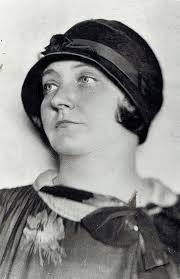
City of Angels, City of Neon. Images from a huge wall of trippy neon, installed in Grand Central Market. Happy Halloween!


City of Angels, City of Neon. Images from a huge wall of trippy neon, installed in Grand Central Market. Happy Halloween!

Aline Barnsdall, heiress and radical. Photo about 1935.
A smart, crazy, independent woman who Inherited millions from her oil-baron father. Hob-nobbed with socialists, supported left-wing candidates, hosted geniuses of all pursuits, including Charles Fletcher Lummis, Charlie Chaplin, and Upton Sinclair. Built Hollyhock House, hiring Frank Lloyd Wright at the beginning of one of his most creative periods, building Los Angeles residences in experimental adobe-like concrete block substitutes. Rudolph Schindler helped complete the project, and personally supervised metal-work details like door handles, etc.
The house was built on the most perfect homesite in the LA basin – a tiny hillock in the perfect climate of Hollywood, rising to its own meadow, looking north upon the backdrop of the sun-splashed Santa Monica Mountains, west to the glow of the shining Bay, east to the silhouette of downtown LA against the snowy San Gabriels. Known as Olive Hill, it is still ringed by shimmering silver olive trees.
As a limousine-liberal of the first water, Aline erected huge billboards along the Hollywood Boulevard side of her property supporting EPIC, Ham and Eggs, and labor martyr Tom Mooney.
She seemed to grow tired of living in a Wright house, spectacularly chic as it is. She got into fights with the City over letting her umpteen dogs run rampant, pooping everywhere on the property. In the 40′s she deeded the entire property to the City of Los Angeles to serve as an art park, which is what it remains today – a beloved and vital campus devoted to classes, studios, and exhibition space for all the fine arts.
It is one of the historic treasures of the city, second in importance, perhaps, only to Griffith Park, for the free civic life of Los Angeles.

More glamour, courtesy of the Hollywood Bowl.
The Muse of Music, by Stanley Green, 1940. This elegant 200-foot long fountain is one of the best pieces of landscape architecture in the world. Wrapping itself around the contours of the hill, the fountain serves as a welcoming gate for visitors to the Hollywood Bowl, but it also serves as a sculptural centerpiece of the entire Cahuenga Parkway, appreciated even by motorists caught in the chokehold traffic of the Pass.
The artist, Mr. Green, also designed the Oscar statuette (trademark, copyright). Hollywood is deeply in this sculptor’s debt. Just as the lure of Oscar’s golden perfection has attracted countless artists here, this graceful Muse, in her serene purity, with her promise of Classical art at popular prices, has inspired countless musicians and composers to bring their “visions of sounds” to Los Angeles. LA was a place for most of the last hundred years far remote from the musical centers of the Old World and East Coast; the Hollywood Bowl’s prestige and popularity changed all that and helped make the City of Angels the cultural capital of the world.